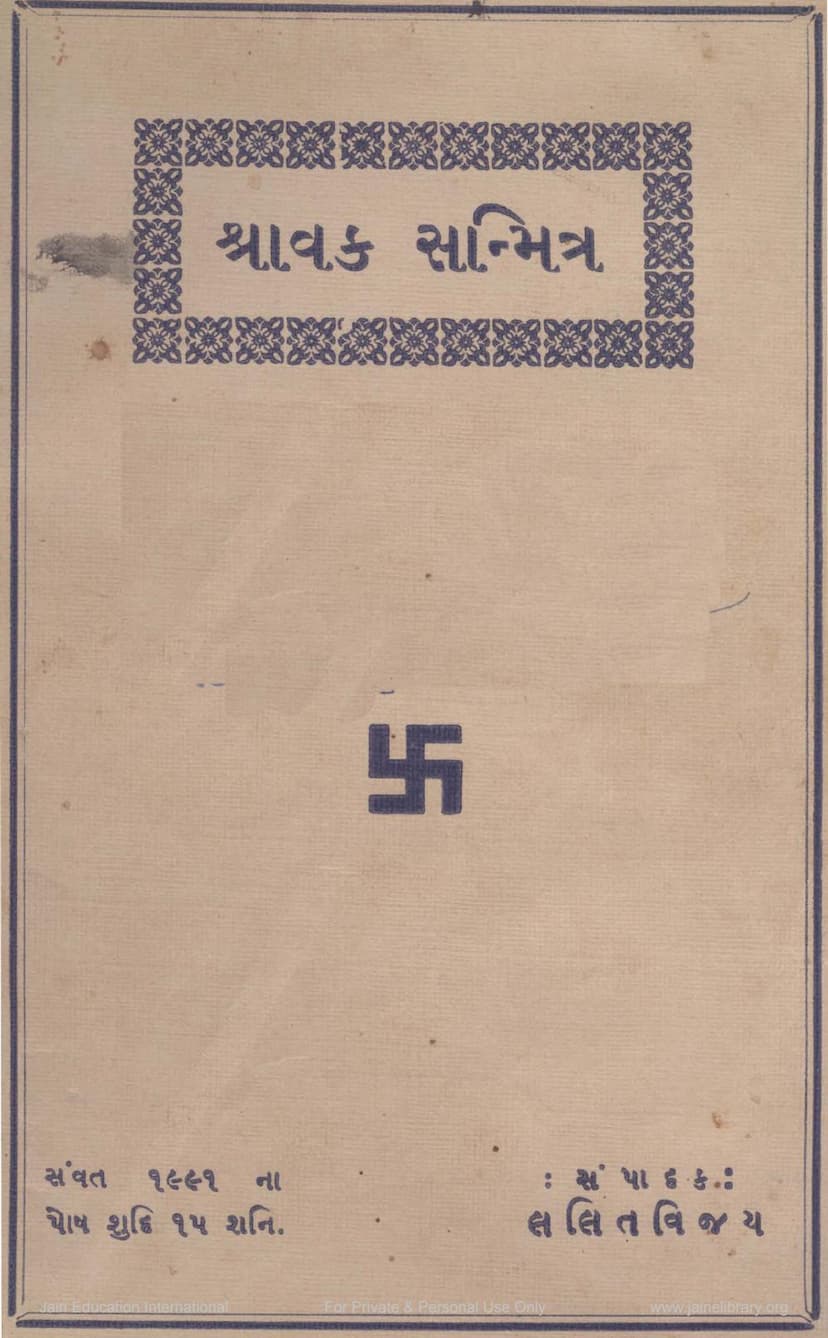Shravaka Sanmitra
Added to library: September 2, 2025

Summary
The Jain text "Shravaka Sanmitra" by Lalitvijay, published by Karpur Pustakalaya Samo, is a comprehensive guide for lay followers (Shravakas) and laywomen (Shravikas) in the Jain tradition. The book, comprising seven parts, aims to provide detailed instructions and explanations on various aspects of Jain practice, ethics, and philosophy.
Here's a breakdown of the key themes and content based on the provided pages:
Core Objective: The primary goal of "Shravaka Sanmitra" is to educate and guide lay followers on how to live a life aligned with Jain principles, leading them towards spiritual progress and ultimately, liberation (Moksha).
Key Content Areas:
-
Vajra Panjar Stotram (Page 4): This section contains a powerful devotional hymn for self-protection, invoking the five supreme beings (Parishtha) of Jainism. It describes the protective power of the mantra and its ability to ward off harm and negativity.
-
Shravaka Karani ni Sajhay (Page 5-14): This is a significant portion of the text, detailing the daily conduct and duties of a Jain lay follower. It covers a wide range of practices and ethical guidelines, including:
- Morning Routine: Waking up early, reciting the Navkar mantra, practicing Samayika (equanimity meditation) and Pratikraman (confession and repentance).
- Devotion and Worship: Visiting the temple, worshipping the divine (Deva), serving the gurus, reciting devotional verses and praises.
- Ethical Conduct: Adhering to vows (Vrata), practicing compassion towards all living beings, giving charity, honest dealings, avoiding forbidden foods (Abhakshya), and refraining from nighttime eating.
- Spiritual Practices: Studying scriptures, contemplating the Tirthankaras (mentioning the 24 Tirthankaras), and dedicating oneself to the path of liberation.
- Specific Vows and Regulations: Detailed explanations on various aspects of Jain discipline, such as rules for eating, drinking, and daily activities, emphasizing purity and non-violence.
- Punya Prabhav Kulak (Pages 6-7): This section highlights the importance of Punya (merit) and how it leads to favorable outcomes, such as obtaining a human birth, being in an Arya-kshetra, having noble lineage, possessing good senses, and understanding the teachings of the enlightened ones (Veetrag-bhashit). It lists various virtuous actions that generate Punya, including devotion to the Tirthankaras and gurus, practice of Samayika, meditation, dharma discussions, charity, compassion, and repentance.
-
Samayika (Pages 8-14): A detailed explanation of Samayika, a significant Jain practice of equanimity and meditation. It covers:
- Its Importance and Fruit: Samayika is described as highly meritorious, yielding immense spiritual benefits, even comparable to vast amounts of wealth or celestial life spans.
- Types of Samayika: Discusses four types: Shruta (knowledge-based), Samayika (equanimity), Deshvirati (partial renunciation), and Sarvavirati (complete renunciation).
- Eight Types of Samayika: Elaborates on eight specific types of Samayika, such as Samabhav (equal-mindedness), Dayabhav (compassion), and Pratyakhyan (renunciation).
- Procedure for Samayika: Provides the correct method for observing Samayika, including posture, recitation, and breaking the observance.
- Atychara (Transgressions): Lists thirty-two transgressions related to Samayika, categorized into those concerning mind, speech, and body, and five specific transgressions (Kaya Dupranidhan, Vachan Dupranidhan, Man Dupranidhan, Anavastha Dosha, Samruti Vihin).
-
Pausadh (Pages 14-17): This section details the observance of Pausadh, a day of fasting and enhanced spiritual practice. It explains:
- Its Fruits and Benefits: Pausadh is described as highly beneficial, akin to performing numerous Samayikas. It helps in overcoming negative emotions and achieving a higher birth.
- Examples of Devotees: Mentions legendary figures like Sagarachandra Kumar, Kamadeva, Chandravat Saraja, Sudhanseth, Sulasa Shravika, Anand Shravaka, and Kamadeva Shravaka who observed Pausadh with great dedication.
- Eighteen Faults and Five Transgressions: Similar to Samayika, it lists specific faults and transgressions to be avoided during Pausadh.
- Procedure for Pausadh: Provides the ritualistic steps for observing Pausadh.
-
Chaitya Vandan and Dev Vandana (Pages 18-19): Explains the rituals for worshipping at a Jain temple (Chaitya Vandan) and venerating the divine images (Deva Vandana), including specific prayers and procedures.
-
Santhara (Pages 20-22): This section describes Santhara, the Jain practice of voluntary fasting until death, a significant act of spiritual discipline. It includes prayers and reflections related to accepting death with equanimity.
-
Various Enumerations and Virtues (Pages 23-198): The latter part of the provided text is a vast compilation of lists, enumerations, and brief explanations of various Jain concepts, virtues, and practices. These include:
- Lists of Virtues and Faults: Describing qualities to cultivate and faults to avoid.
- Types of Beings and their Characteristics: Discussing various categories of souls and their natures.
- Numerical Concepts: Numerous lists organized by numbers (e.g., five Indriyas, six senses, seven vows, eight parts of speech, nine types of Punya, ten types of Senses, eleven types of disciplines, twelve vows, thirteen types of Pious actions, fourteen purities, fifteen types of Punya, sixteen types of Virtues, seventeen types of Knowledge, eighteen types of faults, nineteen types of constellations, twenty types of auspicious objects, twenty-one types of qualities, twenty-two forbidden foods, twenty-three types of meditation, twenty-four Tirthankaras, twenty-five types of anger/kashayas, thirty-two qualifications, thirty-six types of arts, forty-two types of sins, fifty qualifications of a good listener, sixty-eight transgressions of vows, etc.).
- Stories and Examples: Brief anecdotes illustrating Jain principles and the lives of virtuous individuals.
- Rituals and Procedures: Instructions for various religious observances and practices.
- Philosophical Concepts: Explanations of key Jain philosophical terms and ideas.
Overall Significance:
"Shravaka Sanmitra" serves as a practical manual for lay Jains. It emphasizes the importance of consistent practice, ethical living, and devotion as pathways to spiritual development. The text aims to be a constant companion and guide for its readers, offering detailed explanations and encouragement to lead a life of righteousness and detachment. The extensive lists and enumerations provide a rich resource for understanding the breadth of Jain teachings applicable to lay life.